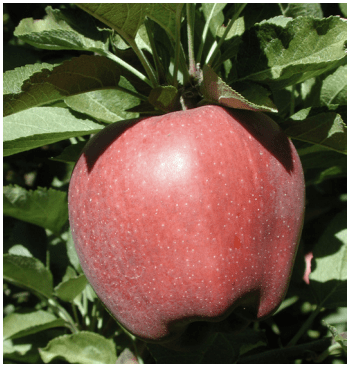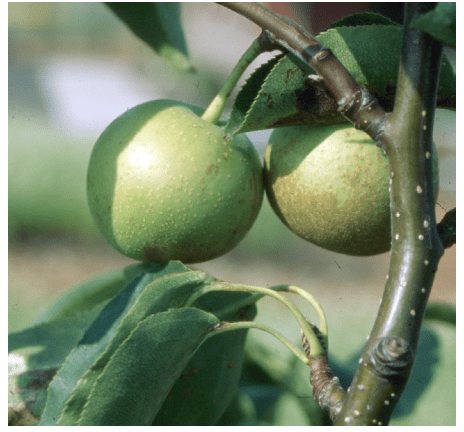Are you interested in growing fruit trees in your landscape? There are several kinds of fruit trees that can be grown successfully in Central Oregon—the challenge lies in selecting varieties that are most likely to bear fruit in this region.
A typical growing season in Central Oregon ranges from 70 to 100 days, depending on where you live (see Central Oregon Climate and How it Relates to Gardening, page 4 in "For more information.") Frost can occur at any time of the year, including when fruit trees are flowering or setting fruit—with possible damage to fruit. Although a tree may grow well, fruit production may vary each growing season. At lower elevation, the milder climate generally increases the chance of producing a successful fruit crop.
Fruit tree varieties
The apple tree is the most reliable fruiting tree in Central Oregon, followed by hardy Asian pear, European pear, plum, and sour cherry. You can also try peach, apricot, sweet cherry, hardy kiwi, and some kinds of nuts, but these trees may not bear consistently.
Pome fruits
Apples
Semidwarf and dwarf apple tree varieties produce fruit in 2 to 3 years. Semidwarf varieties usually are 12 to 15 feet tall. Cross-pollination is recommended for all apple varieties to produce fruit. Crabapples planted within a quarter mile of your apple tree may serve as a pollinizer if bloom times align.
| Variety | Harvest time | Pollinizer | Characteristics | Common uses | Size |
|---|---|---|---|---|---|
| Gala | Fall | Cortland, Honeycrisp, Liberty | Red-yellow; good flavor, sweet; heat-tolerant | Eating | Semidwarf |
| Haralred | Late fall | Yellow Delicious | Red; firm, juicy, tart | All-purpose | Semidwarf |
| Honeycrisp | Fall | Red Baron, McIntosh | Pale red; sweet, very crisp, juicy | Eating, cooking | Dwarf (6-8 ft tall and wide) |
| Liberty | Fall | Freedom, Golden Delicious, McIntosh | Red; great flavor, crunchy, mildly tart; resistant to rust, scab, and fireblight | Eating, juice, sauce | Semidwarf |
| Lodi | Summer | Yellow transparent, Crabapple varieties | Yellow; tart, juicy; very early | Pie, sauces | Semidwarf |
| McIntosh, Red | Late fall | Cortland, Yellow Delicious, Jonathan, Red Baron | Bright red, white flesh; tart; heavy bearer | Eating, cooking, cider | Semidwarf |
Asian pear
Asian pears often are referred to as :apple pears" because of their crisp, juicy texture. Asian pear trees are considered partially self-fruitful. However, in cold climate areas such as Central Oregon, cross-pollination with another Asian or European pear variety is recommended for improved crop set. Asian pears are ripened on the tree.
| Variety | Harvest time | Characteristics |
|---|---|---|
| Atago | Late fall | Sweet, juicy |
| Kosui | Late summer | Best tasting |
| Seuri | Late fall | Brown skin; crisp, sweet, aromatic |
| Shinseiki | Late summer | Yellow skin, white flesh |
| Shinsui | Late summer | Orange; very sweet; reliable |
| Yoinashi | Fall | Brown skin; crisp with butterscotch flavor |
European pear
European pear trees generally require cross-pollination to set a good crop. The varieties listed here are usually suitable as pollinizers for each other, with the exception fo Bartlett (which may bloom too early to effectively pollinize others). European pears are ripened off the tree—they may require a period of cold storage to ripen to best eating quality.
| Variety | Harvest time | Characteristics | Common uses |
|---|---|---|---|
| Bartlett | Late summer | Sweet, juicy; pick when fruit is green - it will change to yellow when ripe | Eating, canning, baking, drying |
| Bosc (russeted or standard) | Fall | Standard types; green skin with some russeting. Russeted types; golden skin. Sweet, juicy; long neck | Eating, baking, drying |
| Conference | Late fall | Green skin can become russeted depending on the weather after bloom; juicy, sweet | Eating, storage |
| Rescue | Fall | Reddish-orange; sweet, smooth, juicy | Eating, canning, drying |
| Orcas | Fall | Large, yellow; juicy, flavorful | Eating, canning, drying |
Stone fruits
Apricots
Apricot trees bloom early in the spring, and their blossoms or young fruit often are damaged by frost. Fruit set in Central Oregon is not reliable.
Sour cherries
Most sour cherries are used for baking in pastries and pies. All of the varieties listed in Table 4 are self-fertile and do not require cross-pollination. Sour cherry trees are more cold-hardy than sweet cherry trees in Central Oregon.
Sweet cherries
All fo the sweet cherry varieties listed in Table 4 are self-fertile and do not require cross-pollination.
Peaches and nectarines
Peaches and nectarine are two of the fruit trees least likely to bear fruit in Central Oregon consistently. Their early spring blooms (nectarines bloom even earlier than peaches) are very susceptible to frost damage. Although the trees may grow well, fruit set is unreliable. Peach trees require heavy fertilization, pruning, and a site with good air movement. Plant peach trees in a protected area.
Plums
Plums are among the more hardy fruit trees in Central Oregon. All of the varieties in Table 4 are European - type plums and are most reliable than Japanese-type piums in a cold climate.
| Fruit | Recommended varieties for Central Oregon |
|---|---|
| Apricots | Self-fertile: Chinese Sweet Pit; Cross-pollination required: Moongold (by either Sungold or Scout), Sungold (by Moongold) |
| Cherries | Sour (all self-fertile): Danube, Montmorency, Northstar, Surefire; Sweet (all self-fertile): Benton, Index, Lapins, Stella, Sweetheart |
| Nectarines | None recommended |
| Peaches | Self-pollinated: Reliance |
| Plums/ Prunes | Self-fertile: Green Gage (Yellow-green), Italian Prune (blue), Mt. Royal (blue), Stanley (blue) |
For more information
OSU Extension publications
- Growing Tree Fruits and Nuts in the Home Orchard (EC 819)
- Growing Prunes (EC 773)
- Training and Pruning your Home Orchard (PNW 400)
- Pruning to Restore an Old, Neglected Apple Tree (EC 1005)
- Picking and Storing Apples and Pears (FS 147)
For more detailed information on selection and cultivation of the fruits listed in this publication, visit the OSU Extension Catalog.
Other resources
- Central Oregon Climate and How it Relates to Gardening. Provides climate information, including precipitation, elevation, growing season, hardiness zones, and other factors.
- Fruit and Nut Orchard Network for Commercial Growers. Oregon State University’s comprehensive site for commercial growers.
- Good Fruit Grower magazine.
- Tree Fruits and Nuts Oregon State University’s comprehensive site for commercial growers
Fruit tree suppliers
Inclusion of suppliers on this list does not mean that the Oregon State University Extension Service either endorses these companies or intends to discriminate against companies not mentioned.
- C & O Nursery, Wenatchee, WA.
- Indiana Berry & Plant Company, Huntingburg, IN.
- One Green World, Mollala, OR.
- Raintree Nursery, Morton, WA.
- Van Well Nursery, Wenatchee, WA.
- Willow Drive Nursery, Ephrata, WA (commercial orchard sales only).
Nursery directories
- Central Oregon’s Plant Resource Guide. Lists local nurseries that sell plant materials.
- Oregon Association of Nurseries Directory and Buyers Guide. Lists wholesale and retail outlets and garden centers.


